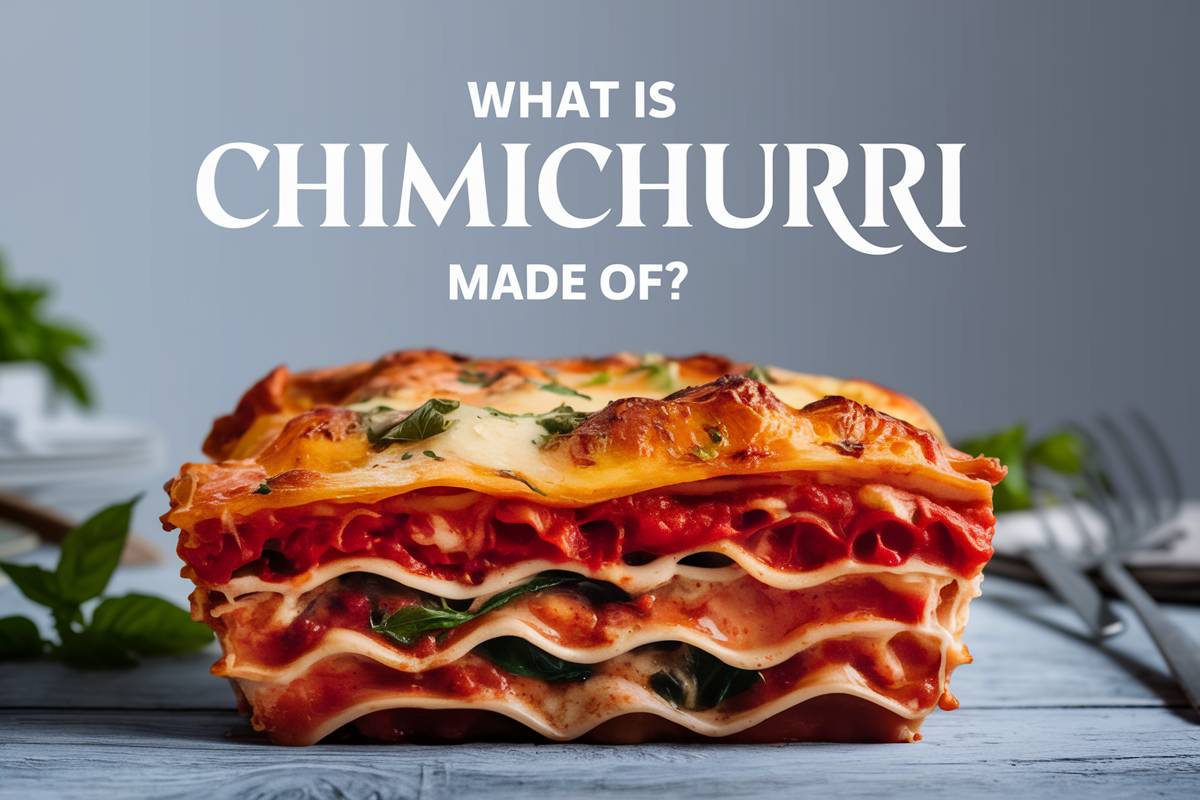Chimichurri is a flavorful sauce originating from Argentina and Uruguay. It’s known for its vibrant and fresh taste, often used as a topping for grilled meats, especially steak. The sauce is simple to make, combining common kitchen ingredients into a zesty, herbaceous mixture.
In this guide, we’ll explore the ingredients of chimichurri, how to prepare it, its variations, and the many ways you can use this delicious condiment to enhance your meals.
What Ingredients Are in Chimichurri?
At its core, chimichurri is made with fresh ingredients that blend to create a bright and tangy flavor. The main components include:
- Parsley: The star of the sauce, offering a fresh, herbal taste.
- Garlic: Brings a sharp bite to balance the herbs.
- Olive Oil: The rich base that gives the sauce its smooth consistency.
- Red Wine Vinegar: Adds a tangy element that balances the oil.
- Oregano: Earthy and slightly bitter, this herb deepens the flavor.
- Red Pepper Flakes: For a bit of heat, but optional.
- Salt and Pepper: Basic seasonings to enhance all the other flavors.
The recipe is flexible, and some cooks enjoy experimenting with variations. For example, cilantro can replace parsley for a different twist.
Types of Chimichurri
Green Chimichurri
Traditional green chimichurri gets its color from fresh parsley. It’s the most common type and is typically served with steak or grilled vegetables in Argentina.
Red Chimichurri
Red chimichurri is a spicier, bolder alternative. It incorporates tomatoes, roasted red peppers, and smoked paprika, giving it a deeper flavor. If you’re a fan of smoky, spicy flavors, this might be your favorite variation.
Both versions work as excellent toppings for a variety of dishes, enhancing flavors without overpowering the food.
How to Use Chimichurri
There are many ways to enjoy chimichurri. Here are some common uses:
- Marinade: The vinegar makes it perfect for tenderizing meats.
- Sauce for Grilled Meats: Especially steak, chicken, or pork.
- Vegetable Dressing: Toss it with roasted or grilled vegetables.
- Sandwich Topping: Adds flavor to wraps and burgers.
The sauce’s versatility means it can be paired with almost anything. It’s similar to other green sauces like pesto or salsa verde. For a different green sauce, explore how chimichurri compares to salsa verde.
How to Make Chimichurri
Making chimichurri is quick, easy, and requires no cooking. Here’s how to do it:
Ingredients:
- 1 cup fresh parsley, finely chopped
- 4 garlic cloves, minced
- 2 tablespoons red wine vinegar
- 1/2 cup olive oil
- 1 teaspoon dried oregano
- 1/2 teaspoon red pepper flakes (optional)
- Salt and pepper to taste
Instructions:
- Chop the Parsley: Finely chop the parsley and place it in a bowl.
- Add Garlic: Mince the garlic and add it to the parsley.
- Season: Stir in the oregano, red pepper flakes, salt, and pepper.
- Mix: Slowly add the vinegar and olive oil, stirring as you go.
- Taste and Adjust: Add more salt, pepper, or vinegar as needed.
Feel free to adjust the recipe to suit your preferences. Some people prefer more vinegar for extra tang, while others may like less garlic.
Once made, chimichurri can be stored in the fridge for up to a week. The flavors will continue to develop over time, making it even more delicious after a day or two.
Common Variations and Substitutions
Chimichurri is highly adaptable. You can easily customize it to suit your tastes by trying these substitutions:
- Swap Parsley for Cilantro: This creates a brighter, citrusy flavor.
- Use Lemon Juice Instead of Vinegar: For a more refreshing and less tangy sauce.
- Change the Oil: Avocado oil or grapeseed oil can offer a different texture.
Each adjustment gives the sauce a new twist, making it a versatile condiment.
FAQs About Chimichurri
Here are answers to some common questions about chimichurri:
1. What is the difference between chimichurri and pesto?
Both are herb-based sauces, but chimichurri uses parsley, garlic, and vinegar. pesto is made with basil, pine nuts, and Parmesan cheese.
2. Can chimichurri be stored in the fridge?
Yes, chimichurri can last up to a week when stored in an airtight container in the fridge. The longer it sits, the more the flavors meld together.
3. How long does chimichurri last?
Chimichurri stays fresh for about a week in the fridge. You can also freeze it in portions to preserve it longer.
4. What dishes pair well with chimichurri?
In addition to grilled meats, chimichurri goes well with roasted vegetables, fish, eggs, and even as a pizza topping.
Conclusion
Chimichurri is a sauce that offers big flavors with minimal effort. Whether you’re using it as a marinade, a sauce for grilled meats, or a dressing for vegetables, it never fails to elevate a dish. Plus, with ingredients like parsley, garlic, and olive oil, it’s as healthy as it is tasty.
Next time you’re grilling or preparing a hearty dish, make a batch of chimichurri and see how it transforms your meal!

